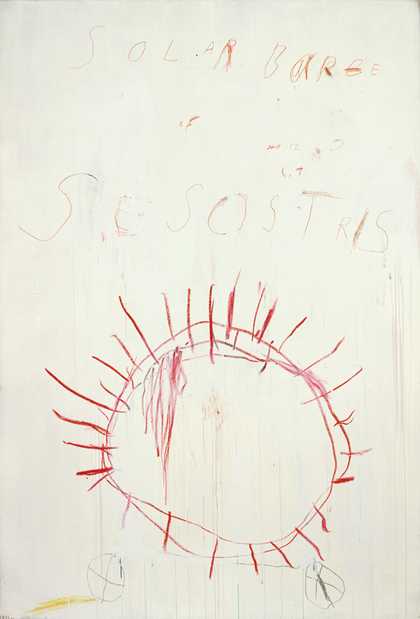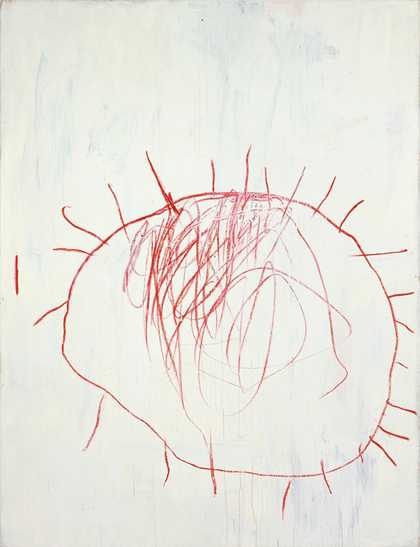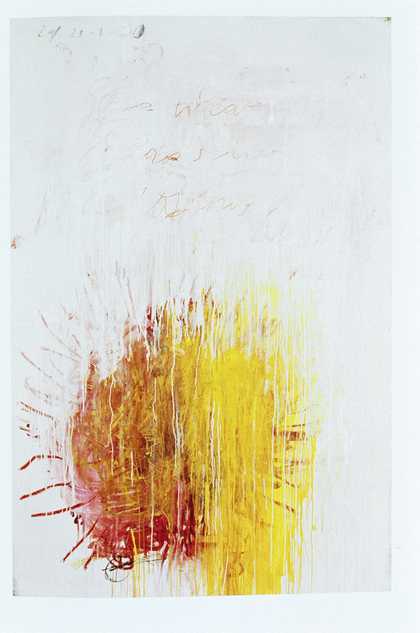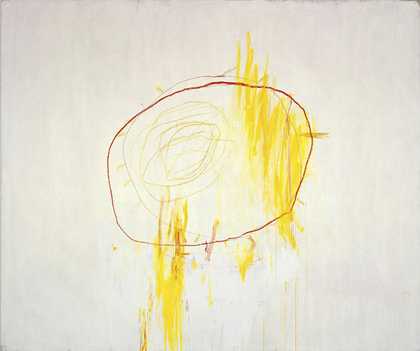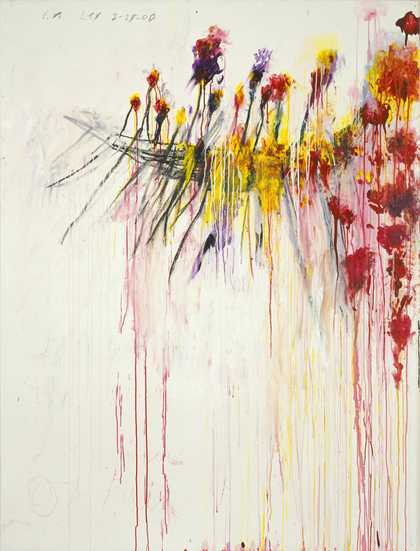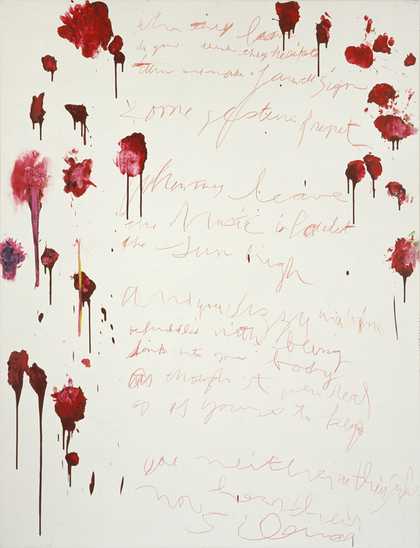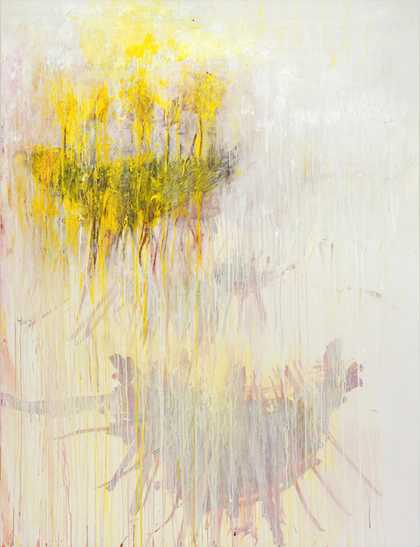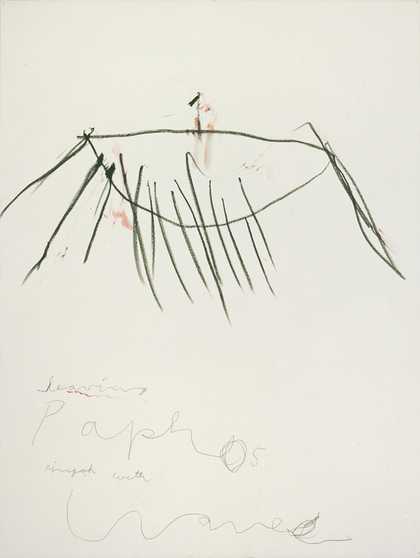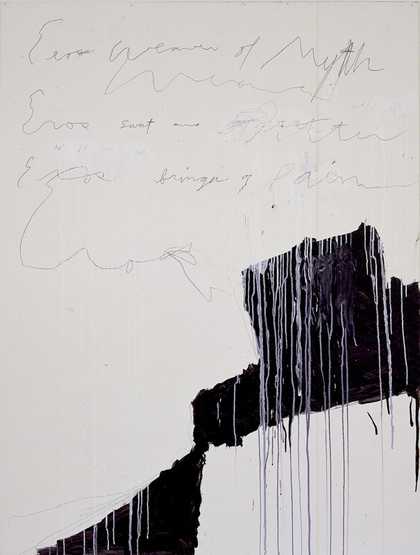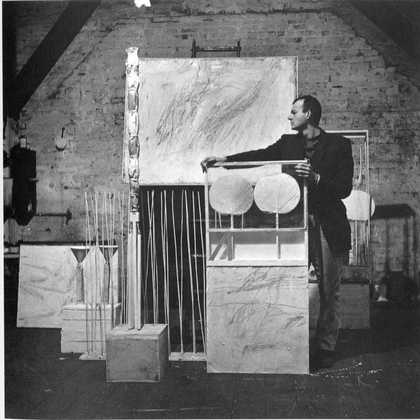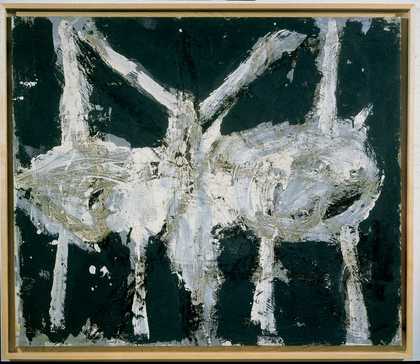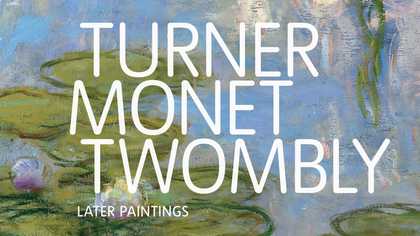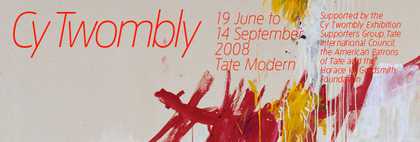Lines have a great effect on paintings
Cy Twombly, interviewed by Nicholas Serota 20071
Walter Benjamin’s 1917 essay, ‘Painting, or Signs and Marks’, argues that, ‘The graphic line is defined by its contrast to area’ as opposed to the mark (‘Mal’) and painting (‘Malerei’): ‘the realm of the mark is a medium.’2 His distinction between line and mark, drawing and painting, is especially hard to maintain in relation to Cy Twombly: the scribbled pencilling, the smudges and smears, are the marks of an affective body used as a writing instrument. Where Benjamin speaks proleptically to Twombly is in the decisive role he gives to writing, inscription, and naming, along with the spatial marks on monuments and gravestones. ‘[T]he linguistic word’, he writes, ‘lodges in the medium of the language of painting.’3 With its collage of quotations, inscriptions, and names, Twombly’s entire oeuvre could be read as a retrospective commentary on this early Benjamin essay.
Modernist translation provides a second form of lineation. Benjamin’s essay on ‘The Task of the Translator’ uses the analogy of geometrical line for the formal relation of translation to original: ‘Just as a tangent touches a circle lightly and at but one point … a translation touches the original lightly and only at the infinitely small point of the sense.’4 Twombly is tangential in just this way: a phrase or a line of poetry evokes a mood or jumpstarts a painting.5 Not surprisingly, he mentions Ezra Pound (1885–1972) and T.S. Eliot (1888–1965) as early influences. Pound made Modernism an age of translations, showing Eliot how to use quotations, and providing a model for the postmodern practice of Charles Olson (1910–1970) in the wake of Pound’s Cantos. Misunderstanding Chinese writing as ideograms, Pound insisted on ‘the look of the characters’ without being able to read Chinese; Louis Zukofsky, knowing no Latin, tried to ‘breathe’ along with Catullus by following his sound, rhythm, and syntax.6 Twombly ‘translates’ – visualises – the Odi di Orazio as pure scribble or scansion (fig.1).
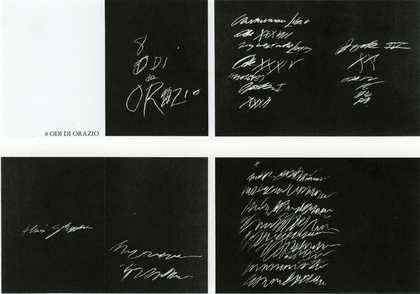
Fig.1
Cy Twombly
8 Odi di Orazio 1968
Screenprint
Pl. I−IV
© Cy Twombly
Lines and phrases – like inscriptions – create genealogies and force fields of allusion. Twombly says he turned to the poets ‘because I can find a condensed phrase … My greatest one to use was Rilke […]. I always look for the phrase.’7 Linked by the legacies of expatriate sensibility and high modernism, Rainer Maria Rilke (1875–1926) and Twombly are also drawn to the richly sedimented Nile region. Both took trips up the Nile to escape the European winter, like other wealthy Europeans in search of the sun. Ancient Egypt is an assemblage of imaginary meanings and colonial expropriation, archaeology and tourism. For Rilke, it was associated especially with poetry, mourning, and the cult of the dead. For Twombly (drawn to epic and historical themes as well as lyric poetry), militarism and conquest converge at the meeting-point of Middle East and western Mediterranean cultures. Hence ‘time-lines’.
Visible signs of the colonial past surround modern time-travellers. The nineteenth-century installation of Cleopatra’s Needle – three ancient Egyptian obelisks, shipped out to European capitals – monumentalise the connection between European Egyptophilia and Egyptokleptia in central London, Paris, and New York.8 For urban Europeans ‘Egypt’ is a composite imaginary that includes colonial conquest as well as death and dying. Tracing the passage from Rilke’s Orphic Egypt to Twombly’s Coronation of Sesostris 2000 – painted, like The Battle of Lepanto series, after the first Gulf War – follows this complex time-line. Along the way, I want to explore some of the graphic technologies – technes of memory – that tie emotion to the line in both Rilke and Twombly: the phonograph; the epigraph; and the ideograph.
Phonograph
Rilke wrote that ‘we are incessantly flowing over and over to those who preceded us and to those who apparently come after us … Transience everywhere plunges into a deep being.’9 Continuous flow, deep time, transience: this is Rilke’s opening onto the Egyptian underworld of the Duino Elegies, which affirm the transformation of living into dead. Rilke says of the Elegies that they evoke ‘age-old transmissions and rumours of transmissions’ belonging to the Egyptian cult of the dead. But the ‘Lament-land’ of the Elegies, he goes on, ‘is not to be identified with Egypt’; rather, it is only ‘a reflection of the Nile country in the desert-clarity of the consciousness of the dead.’10 The collective consciousness of the dead, available to the living, provides his field of allusion.
Rilke’s Sonnets to Orpheus were written at the same time as the Elegies, during 1922. Rilke recalls this outpouring of memorial poetry as borne along by sails associated with his Nile voyage ten years before: ‘the little rust-coloured sail of the Sonnets and the gigantic white canvas of the Elegies’.11 The tenth and last of the Duino Elegies was completed soon after the first of Rilke’s Sonnets to Orpheus, the poetic ‘Tree’ that rises out of the earth when Orpheus sings. The Lament-land of the final elegy contains the reminiscence of temples, sepulchres, and the material cultures of death; but partly - in a cryptic allusion – the outlines of ‘the doubly opened page of a book’ to which the tenth elegy refers. Rilke’s Nile voyage had ended in Cairo with his reading of the Egyptian Book of the Dead.12 A shadowy version of the voyage of the dead man, following the Sun god in his journey across the sky, reappears in the tenth elegy and surfaces in Twombly’s Coronation of Sesostris.
It is hardly surprising that the Sonnets to Orpheus (memorialising a dead girl) should be intertwined with the Nile of Ancient Egypt: in late nineteenth- and early twentieth-century studies of comparative religion, the Egyptian Osiris and the Greek musician-poet Orpheus were often associated.13 But the Nile had specifically poetic meanings for Rilke. The essay he wrote in 1912 soon after his voyage, ‘Concerning the Poet’, recalls that the meaning of the poet was revealed to him on board the large sailing vessel with its sixteen oarsmen which conveyed him up the Nile to the Island of Philae. The crew are unreadable colonial subjects, with ‘the usual silly backshish face’, yet he records their impersonal struggle as they row effortfully upstream against the current.14
At irregular intervals, their rhythmic counting stops and falters, and the singer at the front of the boat gives voice. This sporadic song is Rilke’s allegory of the poet’s ‘place and effect within time’:
In him the forward thrust of our vessel and the force opposed to us were continually held in counterpoise – from time to time a surplus accumulated: then he sang. The boat overcame the opposition; but what could not be overcome … he, the magician, transmuted into a series of long floating sounds, detached in space, which each appropriated to himself. Whilst those about him were always occupied with the most immediate actuality and the overcoming of it, his voice maintained contact with the farthest distance.15
The floating sounds of the Nile boatman occupy the meeting point of deep time and the present: melancholy detachment; contact with the farthest distance; the poet’s contingent relation to time and space.
An essay of 1919, ‘Primal Sound’, remembers the homemade phonographs of Rilke’s classroom. A bristle traced and re-traced the mark of vibrations on a waxed paper cylinder, producing a sound at once fluctuating and unsteady: ‘the sound which had been ours came back to us tremblingly, haltingly from the paper funnel, infinitely soft and hesitating and fading out altogether in places’.16 This faltering and fading sound confronts its listeners with ‘a new and infinitely delicate point in the texture of reality’, an appeal from elsewhere. But what ‘impressed itself on [Rilke’s] memory most deeply’, he writes, was ‘the markings traced on the cylinder’ – the proto-writing of the past: ‘these made a most definite impression’.17
Rilke was later reminded by the coronal sutures of the human skull of ‘one of those unforgotten grooves’ in the home-made cylinder. What if the coronal sutures – like the wavering line engraved by the needle of a phonograph – could be played in a similar fashion? Is there any contour, he wonders, that could not be experienced, ‘as it makes itself felt, thus transformed, in another field of sense?’18 As the techno-critic Friedrich Kittler observes, the skull’s eerie replay would yield ‘a primal sound without a name, music without a notation’ – in other words (his): metaphor.19 The trace is poetry’s ghostly techne. What is the poet, if not a phonograph?
Rilke’s two-part Sonnets to Orpheus contains his most sustained meditation on the poetics of the trace. In the twenty-sixth sonnet of Part I (‘But you, divine one, you, till the end still sounding …’), Orphic song resonates in things even after his death:
… your resonance lingered in lions and rocks
and in the trees and birds. There you are singing still.
O you lost god! You unending trace!
Only because at last enmity rent and scattered you
are we now the hearers and mouth of Nature.20
Orpheus dismembered lingers in a natural world that vibrates like the mouth of a struck bell. The trace – ‘You unending trace’ (‘Du unendliche Spur’) – is the sound-record of this vibration: Rilke’s Spur, or trace, rhymes with Natur. The untranslatable paradox of Rilke’s sonnet makes song the origin of poetry, but death the origin of its dissemination as writing.
Epigraph
Roland Barthes famously wrote of Twombly: ‘His work is based not upon concept (the trace) but rather upon an activity (tracing)’.21 In Twombly’s graphic art, the trace is the record of a gesture. Barthes again: ‘line is action become visible’.22 Like Olson, Twombly connects heart to line via the body. Rilke’s phrase, ‘You unending trace’ (‘Du unendliche Spur’) provides the subtitle of Twomby’s sculpture, Orpheus, 1979, (fig.2).23
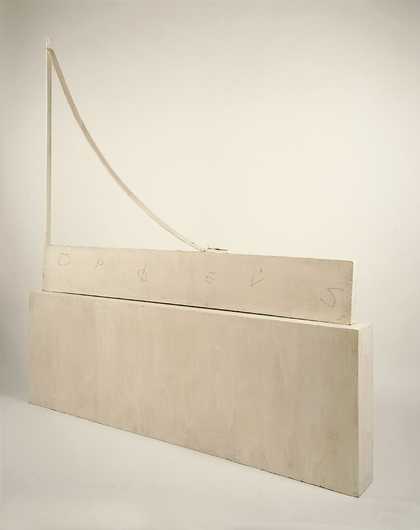
Fig.2
Cy Twombly
Orpheus (Du Unendliche Spur) 1979
Wood, nails, white paint and pencil
The Glenstone Foundation © Cy Twombly
The materials are minimal, tacked together, yet the effect surprisingly impressive in its scale – a lathe rising from an upended plank, linked by a second curved lathe apparently suspended by its own weight. The letters of the name ‘Orpheus’, scattered on the side of the base-board as an epigraph, transform an assemblage of found objects into a monument for a dismembered poet. The slender yet sturdy home-made geometry describes a line that rises and falls as if to infinity.24
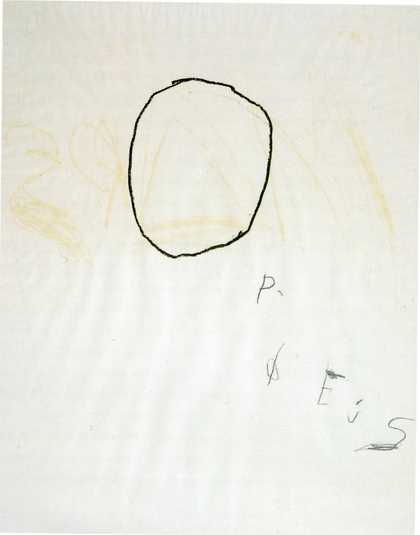
Fig.3
Cy Twombly
Orpheus 1979
Oil, crayon and pencil on paper
Private collection © Cy Twombly
Twombly’s letter-painting Orpheus, 1979 (fig.3) – the same year as his sculpture – opens its initial O to form the basic apostrophic sign of song, spelling out the rest of the name in Greek letters with a random, shaky line, scattering them across an empty surface. Describing space in Twombly’s work, Barthes uses the term ‘rare’ (Latin, rarus): ‘that which has gaps or interstices, sparse, porous, scattered’.25 An earlier Orpheus, 1975 (fig.4), combines the motif of the broken line with another quotation from Rilke’s Sonnets to Orpheus – the ‘ringing glass that shatters as it rings’ – in a poignant geometry of line and smudge.26 The broken sapling of Twombly’s Untitled sculpture of 1987 (fig.5) contains another Orphic reference to the first of Rilke’s Sonnets (‘There rose a tree’). On the pedestal is a small sign bearing an epigraph from the tenth and last of Rilke’s Duino Elegies: ‘And we who have always thought of happiness climbing, would feel the emotion that almost startles when happiness falls.’27
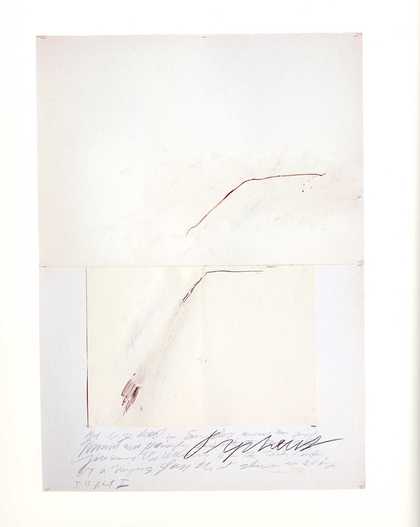
Fig.4
Cy Twombly
Orpheus 1975
Oil paint, pencil, color pencil, scotch tape, collage
© Cy Twombly
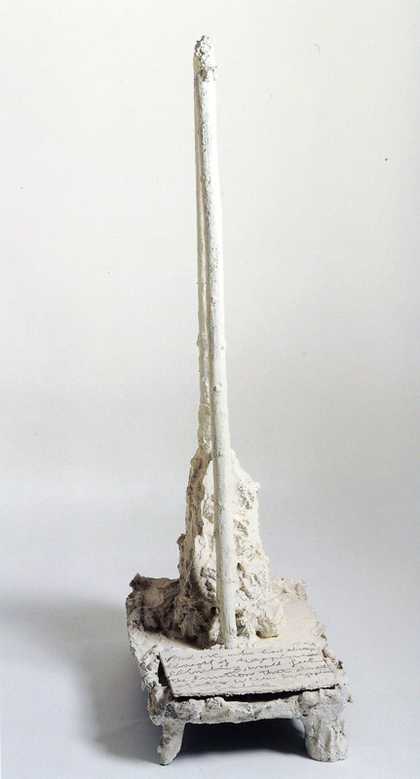
Fig.5
Cy Twombly
Untitled 1987
Bronze, painted with white oil-based paint
© Cy Twombly
Resisting the term ‘graffiti’ (‘naughty or aggressive’ protest) that is often applied to his work, Twombly says that, ‘it’s more lyrical … in the totality of the painting, feeling and content are more complicated, or more elaborate than say just graffiti.’28 Barthes suggests that Twombly’s impossible calligraphy invokes ‘what one might call writing’s field of allusions’ – a cultural field as well as feeling and content; a long way from a fine hand.29 His writing is also epigraphic, in the double sense of alluding to the object or surface on which it is written, and requiring to be deciphered like an ancient inscription. Twombly’s illegible scrawls and polyglot, non-standardised capitals, his interweaving of phrases from high modernist European poets and names from the Graeco-Roman tradition, evoke the longue durée of a commemorative culture that reaches back to Egypt and beyond: cult as well as culture.
Twombly playfully self-identifies with the bucolic poet of the lyric tradition: ‘I am Thyrsis of Aetna, blessed with a tuneful voice’ (Thyrsis, 1977). A 1968 photograph has him in the same shepherd’s pose, leaning against a tree, as the reproduction of Cima’s Orpheus that hung over Rilke’s desk while he was composing the Orpheus sonnets. Much has been made of Twombly’s graphic and sometimes playful self-signing.
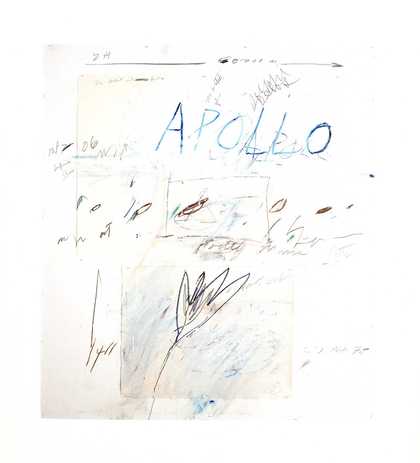
Fig.6
Cy Twombly
Apollo and the Artist 1975
Oil paint, wax crayon, pencil and collage
Courtesy Gagosian Gallery, New York
© Cy Twombly
The collage of Apollo and the Artist, 1975 (fig.6), for instance, contains Twombly’s ideograph for the artist: a lotus-flower tribute that punningly alludes to w, W, or the Greek letter (w) in his own name.30 The lotus combines multiple meanings – the drug that makes the expatriate Odysseus forget his homeland, the sacred flower of ancient Egypt, source of Nilotic fertility and symbol of natural cyclicity.31 But the collage contains other inscriptions: ‘the space between’ and ‘infinite space’ (as well as ‘the artist’, ‘Poetry’, ‘Muses’, and its scribbled measurements). The gap between Apollo and the poet lies in the interstitial and material space that separates these layered and contingent surfaces.
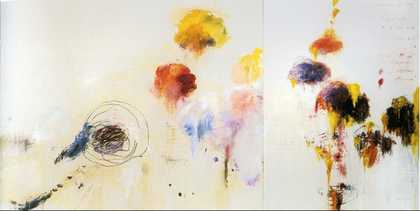
Fig.7
Cy Twombly
Untitled (Say Goodbye, Catullus, to the Shores of Asia Minor) 1994
Oil, acrylic, crayon, oil stick, pencil, and coloured pencil on canvas
© Cy Twombly
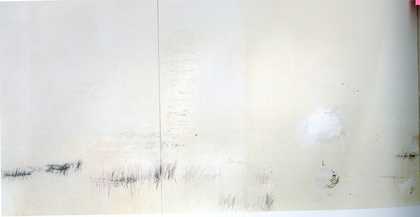
Fig.8
Cy Twombly
Untitled (Say Goodbye, Catullus, to the Shores of Asia Minor) 1994
Oil, acrylic, crayon, oil stick, pencil, and coloured pencil on canvas
© Cy Twombly
Twombly is not an artist of transcendence. His metric is human. He associates his great Untitled (Say Goodbye, Catullus, to the Shores of Asia Minor) painting of 1972–94 (figs.7–8), with ‘life’s fleetingness. It’s a passage.’32 This is at once an expatriate’s farewell and a nostos: ‘I found the idea of Asia Minor extremely beautiful. Saying goodbye to something and coming back on a boat.’33 Who among his American compatriots, he wonders, had ever heard of ‘Asia Minor’?34 (Not so since the first Gulf War). His vast sixteen-metre triptych performs a silent dialogue with Rilke’s ninth elegy: ‘this fleeting world, which in some strange way / keeps calling to us. Us the most fleeting of all.’35 Faced with life’s disappearance and the intensities of its local and human meanings, Rilke’s wanderer brings back, not a handful of earth, but ‘some pure word, the yellow and blue / gentian’: the words for everyday things – house, pitcher, fruit-tree – and the brilliance of colour in things.36
Say Goodbye …, abandons a region of colour, moving from right to left, from the eastern Mediterranean into emptiness and pallor. Catullus is returning to Italy after the death of his brother. Erotic explosions fade, the scribbled ships of Catullus’s homebound ships diminish in the distance, lost in European mists or the white light of the sea. Scattered in the whiteness are letters and fragments of poetry that include the letters of Orpheus’s name.37 As pointed out by Richard Leeman, who has written extensively on the artist, Twombly’s galleys also contain the doomed Argonauts of George Seferis, the modern Greek poet: ‘Their souls became one with the oars and the oarlocks / with the solemn face of the prow … The companions died one by one’.38 For Seferis, whom Twombly elsewhere quotes in a painting for a dying friend named Lucio (alluding to the light-ships of poetry), and again in Quattro Stagioni, farewell to the shores of Asia Minor would have meant the expulsion of Greek refugees from Asia Minor after the defeat of 1922: the restless wanderings of exiles, or today’s economic migrants, washed up on the Italian shore.39
Ideograph
The boat ideograph in Twombly’s painting – a form of self-quotation – is a figure for passage and exile, voyaging and nostos, death and imperial decline.40 More prosaically, it alludes to the commercial rowboats and sailboats that both Rilke and Twombly would have seen on the modern Nile. The prototype is a small ‘Celtic’ boat (oars and mast) photographed by the artist himself (fig.9).41
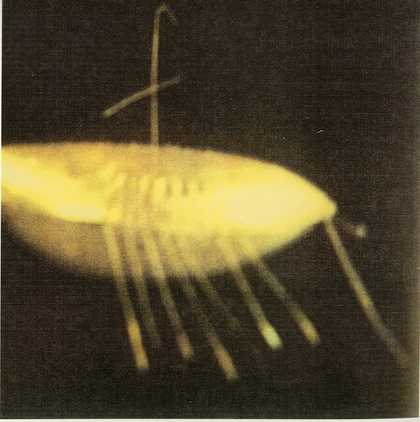
Fig.9
Cy Twombly
Celtic Boat 1994
Courtesy Gagosian Gallery, New York © Cy Twombly
Twombly spent the winter in Egypt during 1984–5, staying in the Old Winter Palace at Luxor, watching the boats go by with their cargoes.42 He was inspired by funeral objects in the Cairo Museum, where he would have seen objects like the funerary barge intended to ship the soul to its afterlife. He might also have seen the perfectly preserved and recently excavated solar barge of King Khufo in its museum setting.
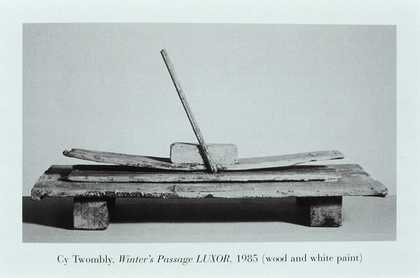
Fig.10
Cy Twombly
Winter’s Passage: Luxor 1985
Bronze
© Cy Twombly
Winter’s Passage: Luxor, 1985 (fig.10), achieves its intimation of mortality with a few stacked pieces of wood: distressed paint, driftwood-like components – two boards, one curved at prow and stern, the other flat on its plinth. The poet David Shapiro calls Twombly’s sculptures ‘toys for broken adults’, saluting their simplicity and pathos.43 The boat seems to glide, carrying its weightless freight, at once a prosaic cargo of today and the shrines transported across the river to the temple of Osiris at Abydos. Is the ship moving or arrested? The critic David Sylvester observes that the oblique line of the stick is both boatman and mast: ‘where the stick’s angle is acute, there is a feeling of serene onward movement, where it is obtuse, a feeling of uncanny stillness’.44 At once in transit and suspended in time, it serves as a symbolic memento for the crossing from the land of the living on the eastern shore of the Nile to the city of the dead on its western shores.
Twombly’s ten-part Coronation of Sesostris, 2000, is the culminating synthesis of his ship ideographs and whirling expeditionary chariots: a blazing, triumphal departure that burns itself out on the far side of the Nile. Begun in Gaeta and completed in Virginia, it combines deceptive simplicity with painterly sophistication and poetic adaptation. Twombly calls this multi-media series (drawn, written, painted) one of his favourite sets and ‘very personal’.45 It incorporates a poem of 1996 by the Southern poet Patricia Waters, not a translation this time, although its title (‘Now is the Drinking’) translates Nunc est bibendum (fig.11).46 With a few strokes and deletions, Twombly ‘interprets’ the poem to create his own reticent version:
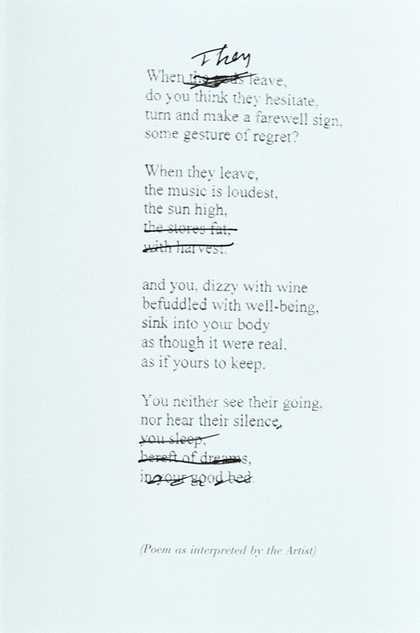
Fig.11
‘Poem as interpreted by the artist’
[Cy Twombly, Coronation of Sesostris
(New York: Gagosian Gallery, 2000), p.29]
Courtesy Gagosian Gallery, New York © Cy Twombly
When they leave,
Do you think they hesitate,
Turn and make a farewell sign,
Some gesture of regret?
When they leave,
the music is loudest,
the sun high,
and you, dizzy with wine
befuddled with well-being,
sink into your body
as though it were real,
as if yours to keep.
You neither see their going,
nor hear their silence.47
Either side of this ambiguous celebration of bodily oblivion, Twombly’s sequence tracks the energetic course of the Pharaonic conquerer, Sesostris II.
Herodotus records that Sesostris, whose name means ‘man of valour’, set up pillars displaying emblems of female genitalia in the cities he conquered to humiliate their inhabitants. An artist of the sexual image (like Twombly), Sesostris consists of a collage of inscriptions, hoaxes, myths, and desires.48 The huge canvases of Coronation of Sesostris chart the arc of a single day, from sunrise to journey’s end. His coronation is his passing, as the solar bark burns its way across the sky. A rudimentary child’s crayon sun rises hugely, then takes the form of the sun-god’s triumphant wheeled chariot (Twombly’s ideograph for military conquest), ushering in the solar bark of Sesostris (figs.12, 13). A fluid sunburst of colour accompanies the half-obscured lines from Sappho that reappear again at the end of the sequence: ‘Eros, weaver [of myth]’, ‘Eros, sweet and bitter, Eros bringer of pain’ (fig.14).49 The glaring sun shines remorselessly, high in the sky (fig.15). Next comes the ceremonial barge, dripping with splendour and yellow and alarazin (crimson) rosettes of paint (fig.16).
Twombly’s ‘interpreted’ poem, ‘When the gods depart’ – gorgeously decorated with his late Mannerist explosions of crimson flowers or liquid fireballs (fig 17) – serves as a hinge between the flaming barge and its dissolution into a burnt-out skeleton (fig.18). The scrawled text provides an epigraph for the series: ‘they’ (the gods) are leaving, glorious but unheeded, as the mortal body sinks into oblivion, scarcely registering their passing. Nunc est bibendum: sorrows are drowned, the boat is a drunken boat, the poem a scribbled memo-to-self, a scarcely legible scrawl with its bursts and drips of paint. The blazing barge dissolves into its own reflection, melting into shadowy, Turneresque reflections in an exquisite coalescing of self-quotation and reminiscence as it sinks beneath the waves (figs.19, 20).50 With the burnt-out stick-ship, the ideograph becomes minimal, like the shadowy Celtic boat, the canvas emptied of colour, the writing undulating and (literally) vague: ‘leaving Paphos ringed with waves’ (fig.20).51
Twombly’s farewell to Eros and the good life quotes, not Archilochos (general and mercenary, as Twombly recalls), but the late Bronze Age poet-warrior, Alkman, who survives only in fragments and phrases. The lines announce a departure from Cyprus (island of love) and Paphos, sacred to Aphrodite: ‘Leaving Kypros the lovely /And Paphos ringed with waves.’52 The solar journey comes to an abrupt halt with a monumental end-stop, and a now-legible epigraph: ‘Eros, weaver of Myth … Eros bringer of pain’ (fig.21). The Gods have departed, along with love. The western bank of the Nile with its blockish steps and temple confronts the viewer with a non-negotiable step into the unknown. The ascending step motif or metric, present in other Twombly paintings and drawings, surfaces as an indecorous quotation of the silhouetted top-hat in Degas’s painting Cotton Exchange in New Orleans (fig.22): ‘So how it got in there, I don’t know’.53 Perhaps Twombly’s eye was drawn to the dazzling commerce in whiteness at the heart of Degas’s picture. He is, after all, a Southern painter.
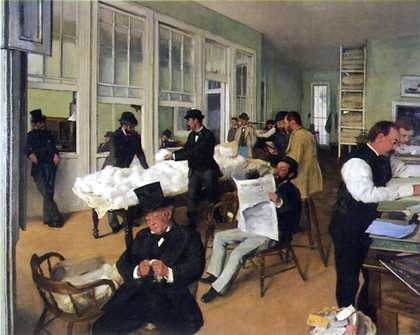
Fig.22
Edgar Degas
Cotton Exchange in New Orleans 1873
Musée Municipal de Pau, France
Seferis’s ‘An Old Man on the River Bank’, written in exile in British-occupied Cairo in 1942, considers ‘towards what we go forward’: not as he hears ‘the companions calling from the opposite shore’ but ‘in some other way’. He summons up the present-day Nile as it moves forward in time and space, between its greenery and ordinary Arab lives, and ‘great tombs even and small habitations of the dead’. Seferis’s old man turns away from the past, since song is sinking beneath its own weight, and art eaten away by gold:
Because we’ve loaded even our song with so much music
that it’s slowly sinking
and we’ve decorated our art so much that its features have
been eaten away by gold
and it’s time to say our few words because tomorrow our
soul sets sail.
In a vertiginous flashback, he remembers how ‘a life that was as it should be’ became dust, ‘and sunk into the sands / leaving behind it only that vague dizzying sway of a tall palm tree’.54 Seferis’s poem of passage anticipates Twombly’s late work, its magnificence and melancholy along with its flowering into new forms of graphic and mnemonic invention: the way his line sways vaguely and dizzyingly across the canvas, carrying its freight of emotion along with its reminder that the body exists in time, not apart from it.

